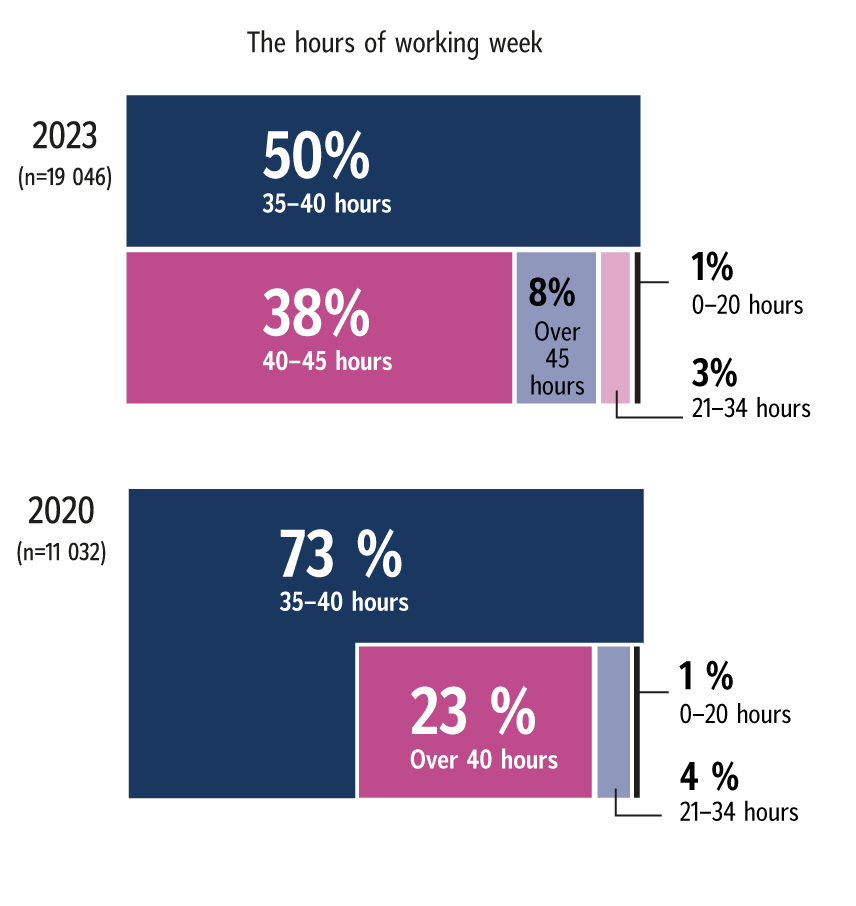Perusduunari muiden joukossa –
6. Workload increases even as the worker ages
The Industrial Union has conducted member surveys on two occasions in 2020 and 2023. The survey is aimed at all members who are available for work on the labour market. Now, after the results of the second member survey are in, it is possible to make comparisons over time. This allows us to gain comparable data on the work of average members as well as on broader changes in working life.
The results of the union’s member survey can be generalised to apply to Industrial Union members. The study is also reproducible as the questions asked in the 2020 and 2023 surveys are nearly identical.
The profiles of the respondents in the surveys are closely aligned with the union’s members as a whole. For example, the level of education, age and gender distribution of respondents are fairly similar to that of all members.
How have the work of Industrial Union members and the working life changed in three years? What have the changes been like? What has stayed the same?

Sharp increase in the length of the workweek
In 2023, a typical workweek for half of Industrial Union members is about 35 to 40 hours. Nearly as many say that their typical workweek is over 40 hours. The share of members who work more than 40 hours a week has doubled in three years. The change is significant and similar among both men and women and in all age groups. Eight percent of members work more than 45 hours a week.
– After a workday, I’m often too tired to do even the necessary chores and don’t recover even when off work,” says one middle-aged woman in the chemicals industry.
– The workload keeps increasing even as the worker is getting older, says one older metalworker.
Workweeks of over 40 hours have become more common in all age groups in the last three years. The change is significant: in three years, the percentage of respondents who work more than 40 hours a week has increased by 23 percentage points.
The extension of the workweek suggests that employees increasingly work weekends and overtime. The reasons for working overtime are related to increasing the volume of industrial production and the fact that workplaces are often understaffed.
Many employees are also willing to work overtime. Men in particular are keen on working extra hours. As two middle-aged men in the metal industry put it: “Overtime is what it’s about. The pay increase helps a lot” and “Funnily enough, overtime cheers you up when you know there’s a bigger paycheck coming.”
No change in the nature of employment
Between 2020 and 2023, the labour market position and nature of employment relationship of Industrial Union members saw only minor changes. The percentage of permanent and full-time employees saw slight increases.
The most significant change has been in the number of unemployed members. In 2020, one in ten members were unemployed. Three years later, the percentage was clearly lower (6.9%). The percentage of laid-off members was low at the time of both surveys (2.2%). These figures are part of a broader trend of an improved employment situation in the last few years.
There are no notable changes in the number of jobs held by members. The situation seems fairly stable. However, the number of previous jobs held strongly correlates with age: the younger the worker, the more past employment relationships they have had, while the opposite is true for older workers.
On average, those in working life have not been employed by one employer for quite as long. In 2023, half of the respondents had started in their current job between 2015 and 2020. One in four respondents had started in their current job relatively recently, between 2020 and 2023. The percentage of members working in the same job has remained steady in the last three years.
The results also show that if a member has held several jobs since 2020, they are also more likely to have moved for work or have a second home close to the place of work. However, moving for work has become less common in the last three years. A clearly larger percentage of respondents than before say that they have considered changing jobs.
The most common reasons for changing jobs are the same as three years ago. They include better pay, more meaningful work, and poor leadership. The length of the commute was the reason for one in five respondents who say they have considered changing jobs in 2023. This option was not among those listed on the 2020 member survey form.
